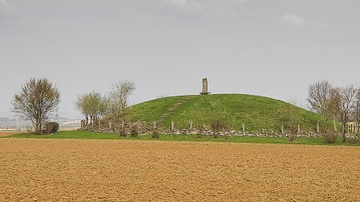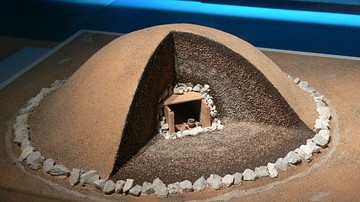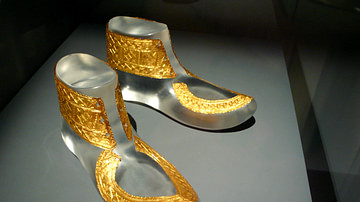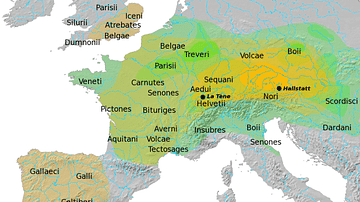Illustration
A reconstruction of an Iron Age grave from Hochdorf an der Enz in Baden-Württemberg, Germany. This burial mound is associated with the Hallstatt Culture, and the man interred is believed to have been a Celtic "prince" or chieftain. The grave dates to around 530 BCE, and is located near the remains of a Celtic village which contained several farmsteads.
It contained a wagon and a large bronze cauldron filled with about 400 litres (100 gallons) of mead, nine drinking-horns, and tableware for nine people. The chieftain was about 40 years old and over 6 feet tall (unusually large for an Iron Age individual). He was wearing a birch hat, brightly coloured clothing, a gold torc, bracelet, and several amber beads. The grave goods also included a comb, a dagger, fishing hooks, arrows, and other tools made of bone, bronze, and antler. From the Celtic Museum in Hochdorf, Germany.
Cite This Work
APA Style
Hagdorn, M. (2019, June 17). Reconstruction of the Hochdorf Chieftain's Grave. World History Encyclopedia. Retrieved from https://www.worldhistory.org/image/10932/reconstruction-of-the-hochdorf-chieftains-grave/
Chicago Style
Hagdorn, Magnus. "Reconstruction of the Hochdorf Chieftain's Grave." World History Encyclopedia. Last modified June 17, 2019. https://www.worldhistory.org/image/10932/reconstruction-of-the-hochdorf-chieftains-grave/.
MLA Style
Hagdorn, Magnus. "Reconstruction of the Hochdorf Chieftain's Grave." World History Encyclopedia. World History Encyclopedia, 17 Jun 2019. Web. 31 Oct 2024.







